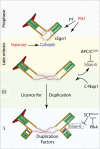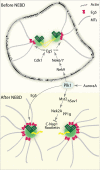Breaking the ties that bind: new advances in centrosome biology
- PMID: 22472437
- PMCID: PMC3317805
- DOI: 10.1083/jcb.201108006
Breaking the ties that bind: new advances in centrosome biology
Abstract
The centrosome, which consists of two centrioles and the surrounding pericentriolar material, is the primary microtubule-organizing center (MTOC) in animal cells. Like chromosomes, centrosomes duplicate once per cell cycle and defects that lead to abnormalities in the number of centrosomes result in genomic instability, a hallmark of most cancer cells. Increasing evidence suggests that the separation of the two centrioles (disengagement) is required for centrosome duplication. After centriole disengagement, a proteinaceous linker is established that still connects the two centrioles. In G2, this linker is resolved (centrosome separation), thereby allowing the centrosomes to separate and form the poles of the bipolar spindle. Recent work has identified new players that regulate these two processes and revealed unexpected mechanisms controlling the centrosome cycle.
Figures



Similar articles
-
Separate to operate: control of centrosome positioning and separation.Philos Trans R Soc Lond B Biol Sci. 2014 Sep 5;369(1650):20130461. doi: 10.1098/rstb.2013.0461. Philos Trans R Soc Lond B Biol Sci. 2014. PMID: 25047615 Free PMC article. Review.
-
Mechanism limiting centrosome duplication to once per cell cycle.Nature. 2006 Aug 24;442(7105):947-51. doi: 10.1038/nature04985. Epub 2006 Jul 19. Nature. 2006. PMID: 16862117
-
Emerging roles of centrosome cohesion.Open Biol. 2022 Oct;12(10):220229. doi: 10.1098/rsob.220229. Epub 2022 Oct 26. Open Biol. 2022. PMID: 36285440 Free PMC article. Review.
-
PLK4 is a microtubule-associated protein that self-assembles promoting de novo MTOC formation.J Cell Sci. 2018 Nov 9;132(4):jcs219501. doi: 10.1242/jcs.219501. J Cell Sci. 2018. PMID: 30237222 Free PMC article.
-
A Cell-Free System for Real-Time Analyses of Centriole Disengagement and Centriole-to-Centrosome Conversion.Methods Mol Biol. 2016;1413:197-206. doi: 10.1007/978-1-4939-3542-0_13. Methods Mol Biol. 2016. PMID: 27193851 Free PMC article.
Cited by
-
Aurora A and AKT Kinase Signaling Associated with Primary Cilia.Cells. 2021 Dec 20;10(12):3602. doi: 10.3390/cells10123602. Cells. 2021. PMID: 34944109 Free PMC article. Review.
-
Degradation of Cep68 and PCNT cleavage mediate Cep215 removal from the PCM to allow centriole separation, disengagement and licensing.Nat Cell Biol. 2015 Jan;17(1):31-43. doi: 10.1038/ncb3076. Epub 2014 Dec 15. Nat Cell Biol. 2015. PMID: 25503564 Free PMC article.
-
C-Nap1 mutation affects centriole cohesion and is associated with a Seckel-like syndrome in cattle.Nat Commun. 2015 Apr 23;6:6894. doi: 10.1038/ncomms7894. Nat Commun. 2015. PMID: 25902731 Free PMC article.
-
Centrosome dysfunction contributes to chromosome instability, chromoanagenesis, and genome reprograming in cancer.Front Oncol. 2013 Nov 12;3:277. doi: 10.3389/fonc.2013.00277. eCollection 2013. Front Oncol. 2013. PMID: 24282781 Free PMC article. Review.
-
Multisite phosphorylation of C-Nap1 releases it from Cep135 to trigger centrosome disjunction.J Cell Sci. 2014 Jun 1;127(Pt 11):2493-506. doi: 10.1242/jcs.142331. Epub 2014 Apr 2. J Cell Sci. 2014. PMID: 24695856 Free PMC article.
References
Publication types
MeSH terms
Substances
LinkOut - more resources
Full Text Sources
Miscellaneous

